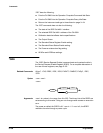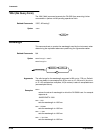
Status and Events
Programming
3 --- 38
The Event Status Enable Register (ESER) — isshowninFigure3-9.It
controls which types of events are summarized by the Event Status Bit
(ESB) in the SBR.
Use the *ESE command to set the bits in the ESER, and use the *ESE?
query to read it.
PON URQ CME EXE DDE QYE RQC OPC
76543210
Figure 3-9: The Event Status Enable Register (ESER)
The Service Request Enable Register (SRER) — is shown in Figure
3-10. It controls which bits in the SBR generate a Service Request and are
summarized by the Master Status Summary (MSS) bit.
Use the *SRE command to set the SRER. Use the SRE? query to read it.
The RQS bit remains set to one until either the Status Byte Register is read
with a Serial Poll or the MSS bit changes back to a zero.
——ESB MAV ————
76543210
Figure 3-10: The Service Request Enable Register (SRER)
The Enable Registers and the *PSC Command
The *PSC command controls the contents of the Enable Registers at power-
on. Sending *PSC 1 sets the Enable Registers at power on as follows:
H DESER 255 (equivalent to a DESe 255 command)
H ESER 0 (equivalent to an *ESE 0 command)
H SRER 0 (equivalent to an *SRE command)
Sending *PSC 0 lets the Enable Registers maintain their values in nonvola-
tile memory through a power cycle.
NOTE
To enable the PON (Power On) event to generate a Service Re-
quest, send *PSC 0, use the DESe and *ESE commands to enable
PON in the DESER and ESER, and use the *SRE command to
enable bit 5 in the SRER. Subsequent power-on cycles will gener-
ate a Service Request.


















